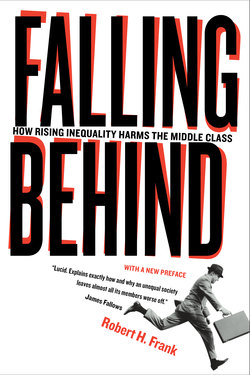Читать книгу Falling Behind - Robert Frank - Страница 12
На сайте Литреса книга снята с продажи.
ОглавлениеCHAPTER THREE
Inequality, Happiness, and Health
With evidence on recent trends in income and wealth inequality in hand, we are now in a position to attempt to answer the question before us: Does rising inequality harm the middle class? One way to approach it is to try to answer a closely related question: Does growing inequality make the middle class less happy? Although few economists would pose such a question, I am persuaded that much can be learned from an attempt to answer it. As a first step, we require a workable measure of happiness. So I will briefly survey some highlights from the large literature devoted to the measurement of human happiness and well-being.
Psychologists and other behavioral scientists have for several decades been trying to measure what they call subjective well-being.1 I once asked Ed Diener, a pioneering researcher in this area, why he and his colleagues use that term instead of just saying happiness. He said, “Well, it is happiness that we’re studying, but we’d be much less likely to get NSF grants if we called it that. They wouldn’t think it was scientific enough.” But even though subjective well-being and happiness have much in common, the two concepts are not identical. Subjective well-being depends in part on how one feels at a given moment, but it also entails considered judgments about the overall quality of one’s life.
In practice, one of the principal measures of subjective well-being comes in the form of responses to surveys that ask people to classify themselves into one of three categories: very happy, fairly happy, or not happy. Other surveys ask subjects to respond on a ten-point scale to questions like “All things considered, how satisfied are you with your life these days?”
Economists often voice strong misgivings about such measures. What can we possibly learn, they wonder, by posing questions like that? This is the United States, after all, and most people know they are supposed to be happy here. But although some people may overstate their personal happiness levels on that account, a significant proportion are willing to admit to being only fairly happy. And a minority—a small minority, but still a sizable number—classify themselves as not happy.
What is more, people are consistent in their responses. Their answer to a given question is likely to be the same eight months from now as it is today. If we try to measure happiness in other, less direct, ways, the results accord closely with the results we get when we just ask people whether they are happy. Suppose, for example, that a subject is asked to indicate on a five-point scale the extent to which he agrees with statements like “When good things happen to me, it strongly affects me,” or “I often do things for no other reason than that they might be fun.” (Five points indicates “strongly agree” and one point indicates “strongly disagree.”) People who strongly agree with such statements are likely to have classified themselves as happy in response to an overall happiness question. Conversely, those who strongly disagree are likely to have classified themselves as unhappy.2
Figure 6. Electrical measurement of happiness. Photograph courtesy of Richard J. Davidson.
Similarly, people who call themselves happy are much more likely to register strong agreement with statements like “When I get something I want, I feel excited and energized.” Those who classify themselves as unhappy apparently do not feel that way. Happy people agree strongly that “When I am doing well at something, I love to keep at it,” whereas unhappy people often seem not even to understand what such statements are getting at.
Neuroscientists also assess emotional valence by measuring asymmetries in brain waves. The device they employ, shown in figure 6, is quite remarkable. They hook you up to a host of electrodes that measure waves in electrical activity emitted from various parts of the brain. If you have brain-wave patterns emanating disproportionately from the right prefrontal region of your brain, you are much more likely to say you are not happy in response to survey questions. And you are much more likely to disagree with statements like the ones I just mentioned. In contrast, if your brain-wave patterns emanate disproportionately from the left prefrontal region, you are much more likely to call yourself happy when somebody asks you, and much more likely to agree strongly with the statements mentioned.3
